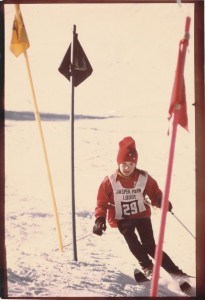 The Lake Louise Downhill, 1969.
The Lake Louise Downhill, 1969.
I stood in the start gate, staring down at the downhill piste in front of me; I didn't see the spectacular beauty across the valley, the iconic white encrusted peaks that have enthralled tourists for generations.
My coach, Joe Couture, was with me, rubbing some blood back into my scared and stiff legs. He places his hand on my shoulder, a warm and reassuring pressure as I placed my poles for the start.
The starter counted: three, two, one, GO! I left the start gate in a flurry of mad poling and ski skates, as Joe’s HUP, HUP, HUP pierced the frigid and still air of -20. I settled into the run, tucking, arms forward, aerodynamic, as I started to pick up speed over Wiwacky Flats. Flat ski, flat ski. I break out of my tuck to properly ski the GS turns, using the late 1960s ski technique of “drive your knee in.” My sharp edges bit in, I held the turns, my legs were starting to shake!
I hurtled over the Waterfall, and with Joe’s instructions thumping in my brain, I set up for the dreaded S-turn; an extremely difficult fall away, off camber, teeth-rattling side hill with frozen grooves, lumps and bumps.
By now my vision was a blur and my helmet was loose on my head. A heart beat later I was in the Gunbarrel. Miraculously I shot out of the barrel, a bullet with all limbs intact just to stare down with fright at the sight of Double Trouble, a tunnel of speed, lined with massive spruce trees.
Double Trouble are two large high speed prejumps/bumps, that demand precision and commitment. They separate the wheat from the sheaf and this small kernel remained intact, as I clattered over the rocky mountain ice to finally see the long straight before the finish.
I tucked straight through and somehow managed to throw my aching jelly legs to a full downhill stop. The finish area can be a lonely place; my heart was exploding out of my chest, as my wild eyes searched for Coach Joe. Seconds blur, and I feel a jacket wrapped around me as Joe said, “Great run, now go up and help the other kids.” I was 10 years old.
The late Joe Couture was the ski coach during the early years at Marmot Basin from 1965 through into the mid 1970s. There was many a kid who stood proudly in his line up, while he taught us the basic necessities of the stem Christie ski technique, and how to go fast on skis.
In 2010, during the winter Olympics in Vancouver, the Jasper Museum asked if I would do a talk on what it takes to be an Olympian.
“Yikes,” I thought, and said I’d think about it. What could I possibly talk about? What would I say? It’s been decades since my Olympics, which were held in Lake Placid in 1980. Would I remember anything relevant? I took a deep breath, and said “yes.”
I accepted for a number of reasons. I knew it would be good for me to think long and hard about the what and the whys. Sure, it takes talent and dedication, we all understand those words, but what really makes an Olympian? I realized it all starts when you’re a kid and, for it to work, many things have to align: a program, volunteers, keen parents, plenty of luck and most important of all, a coach. Not just any coach, but a coach who has an inherent knack and ability to garner respect from the kids, and who can make a difference at an impressionable age.
Joe was this special breed of coach.
Joe was the man; as coach of the Jasper Ski Team, he stiffened up our ski boots—which barely covered our ankles—with discipline and determination. Joints, muscles and tendons were honed and strengthened with countless, insufferable burpees, pushups, wall squats and bench jumps. He confidently warmed our scrawny frames—inadequately clothed with threadbare fibres trapping the wind off Marmot Peak. He taught us structure, balance and timing with every pole plant, knee angulation and the dreaded Spiess.
We side stepped (although sometimes with grumbles) up many a slalom course set with bamboo poles, memorizing the line and the course with good behaviour and respect. Skis were sharpened and waxed in the furnace room of a hotel with reluctant enthusiasm and a ski racers duty.
Teamwork was praised—being out of line, rude and obnoxious was not tolerated. Joe often told us, “when you wear the ski team jacket, you don’t only represent the team, but Jasper as well.”
This is what Joe expected and demanded. It was communicated with authority; a quiet, but mighty voice that roared.
All who went through Joe’s coaching program not only grew into decent human beings, but many of us schussed our early skills even further, going onto the Alberta Ski Team—and for Chris McCready and I, onto the Canadian National Team.
Thinking about Joe, my brother Rob recollects, “It was the early 1970s, I was nine. My feet had grown a lot over the summer, and my ski boots didn’t fit anymore. My toes were stuffed in there, and wearing them was agony.
“Money was tight, and dad couldn’t afford to buy me a new pair of ski boots. One day, Joe came over and handed me a spanking brand new pair of Dolomite ski boots. When Joe left, I asked dad, why did he do that? Dad replied, that’s the kind of man he is.”
Thanks, Joe. You’ve influenced, inspired, and motivated 50 years of Jasper's history.
And you sure made a difference in the early years of ski racing in Jasper. My legs still have that old A-frame twitch.
Loni Klettl
Special to the Fitzhugh
